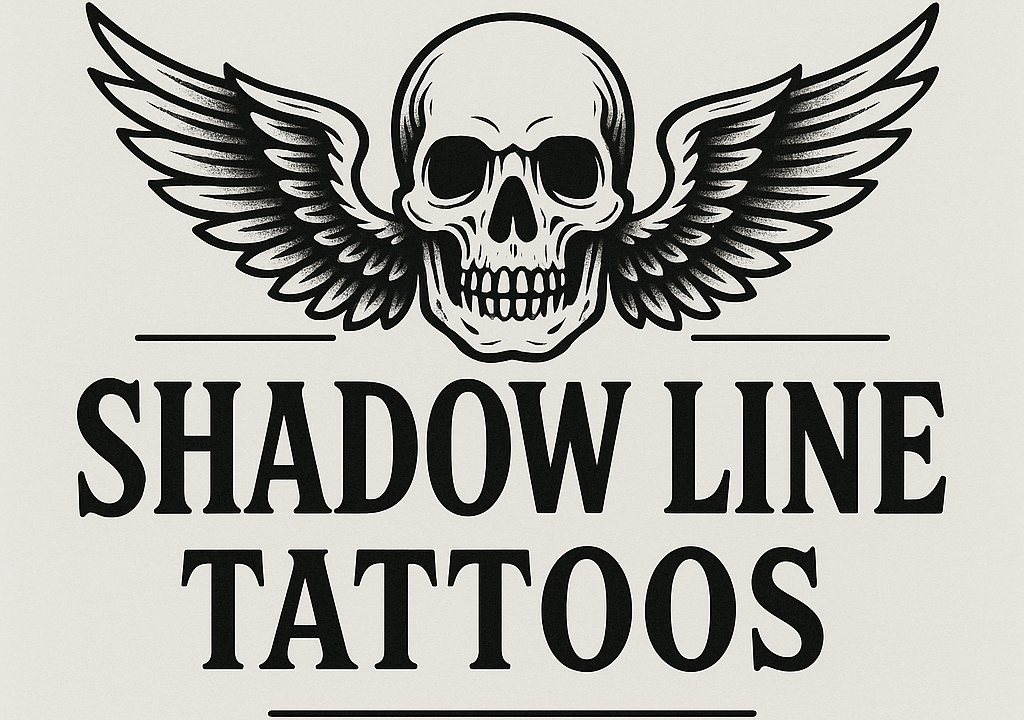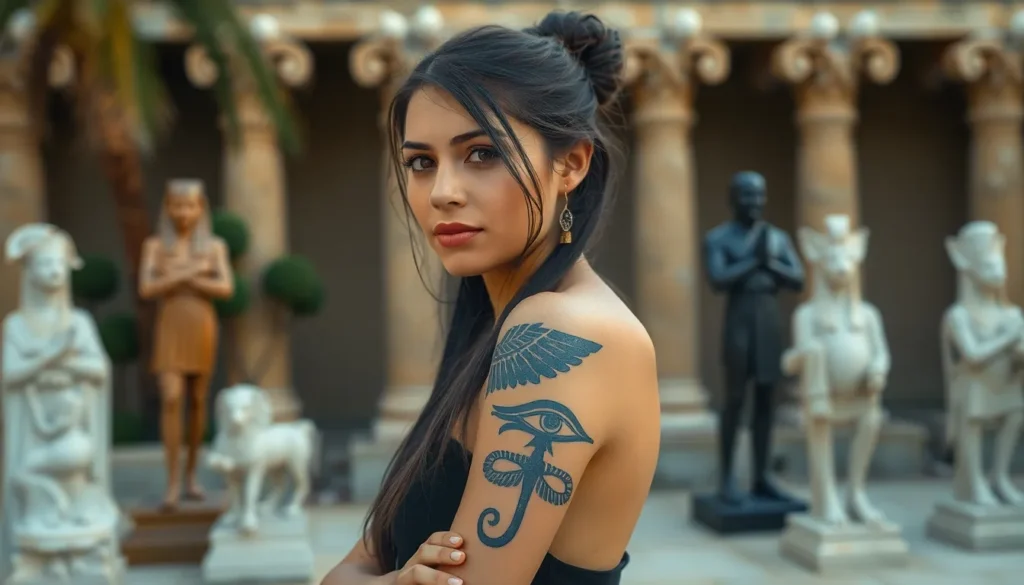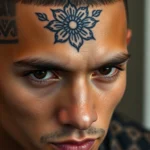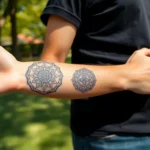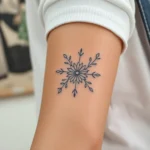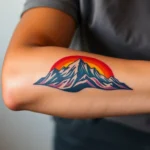Ancient Egyptian civilization continues to captivate us with its mysterious symbols and powerful imagery that translate beautifully into stunning tattoo art. We’ve discovered that Egyptian tattoos aren’t just decorative pieces—they’re profound statements connecting modern wearers to one of history’s most fascinating cultures.
From the iconic Eye of Horus to intricate hieroglyphics and majestic pharaohs, Egyptian tattoo designs offer endless possibilities for meaningful body art. We’ve seen how these timeless symbols represent protection, wisdom, and spiritual guidance, making them perfect choices for those seeking tattoos with deeper significance.
Whether you’re drawn to minimalist ankh symbols or elaborate full-sleeve depictions of Egyptian gods, we’ll guide you through the most compelling design options that honor this ancient civilization’s rich heritage while creating stunning modern tattoos.
Ancient Egyptian God and Goddess Tattoo Designs
Divine figures from Egyptian mythology offer some of the most striking and meaningful tattoo options for those seeking powerful spiritual connections. These deities represent fundamental aspects of life, death, and the natural industry that continue to resonate with modern tattoo enthusiasts.
Anubis: The Jackal-Headed Guardian of the Afterlife
Anubis tattoos capture the mysterious essence of Egypt’s most recognizable death deity through his distinctive black jackal head paired with a human body. We often see these designs featuring Anubis holding the scales of judgment, where he weighs hearts against the feather of Ma’at to determine souls’ worthiness for the afterlife. Popular placements include the forearm, back, and chest, where the vertical nature of standing Anubis figures creates dramatic visual impact.
Artists frequently incorporate hieroglyphic borders, pyramids, or mummy wrappings around Anubis designs to enhance the ancient Egyptian atmosphere. Black and gray ink works exceptionally well for these tattoos, though some people choose golden accents to highlight ceremonial elements like jewelry or the scales. The protective symbolism makes Anubis particularly meaningful for those who work in dangerous professions or have experienced important loss.
Bastet: The Feline Goddess of Protection and Joy
Bastet designs celebrate the beloved cat goddess who protected homes, women, and children throughout ancient Egypt. We see these tattoos ranging from realistic cat portraits with Egyptian jewelry to full goddess figures with feline heads adorned in golden accessories. Many people choose to include sacred cats, ankh symbols, or lotus flowers alongside Bastet to emphasize her nurturing and protective qualities.
Traditional Egyptian art styles work beautifully for Bastet tattoos, featuring bold outlines and flat color blocks that mirror ancient wall paintings and sculptures. Cat lovers particularly gravitate toward these designs, often incorporating their own pets’ features into the goddess imagery. Placement options include the shoulder, thigh, or ribcage, where curved areas complement the graceful feline form.
Horus: The Falcon God of Sky and Kingship
Horus tattoos showcase the powerful falcon deity through his iconic bird head crowned with the double crown of Upper and Lower Egypt. We frequently encounter designs featuring Horus with outstretched wings, the Eye of Horus symbol, or solar disk imagery that represents his connection to the sun and sky. These tattoos often incorporate rich blues and golds to reflect his celestial nature and royal status.
Wing designs extending across the back or chest create particularly impressive Horus tattoos that emphasize his role as sky god. Some people choose smaller Eye of Horus symbols as standalone pieces, while others prefer full deity portraits with elaborate Egyptian regalia. The protective and leadership symbolism appeals to those in positions of authority or seeking guidance through life challenges.
Isis: The Divine Mother and Goddess of Magic
Isis tattoos honor the most revered goddess in Egyptian mythology through designs featuring her distinctive throne headdress or protective wing imagery. We observe these tattoos often including magical symbols like the tyet knot, stars, or hieroglyphic invocations that emphasize her role as a powerful sorceress and healer. Mother figures particularly connect with Isis designs that showcase her nurturing aspects and protective embrace.
Flowing robes, outstretched wings, and intricate jewelry details make Isis tattoos incredibly feminine and elegant. Artists often use soft shading techniques and jewel tones to create ethereal, magical effects that capture her divine essence. Popular placements include the back, where winged designs can span the shoulder blades, or the forearm, where vertical compositions highlight her regal bearing.
Hieroglyphic and Ancient Script Tattoo Ideas
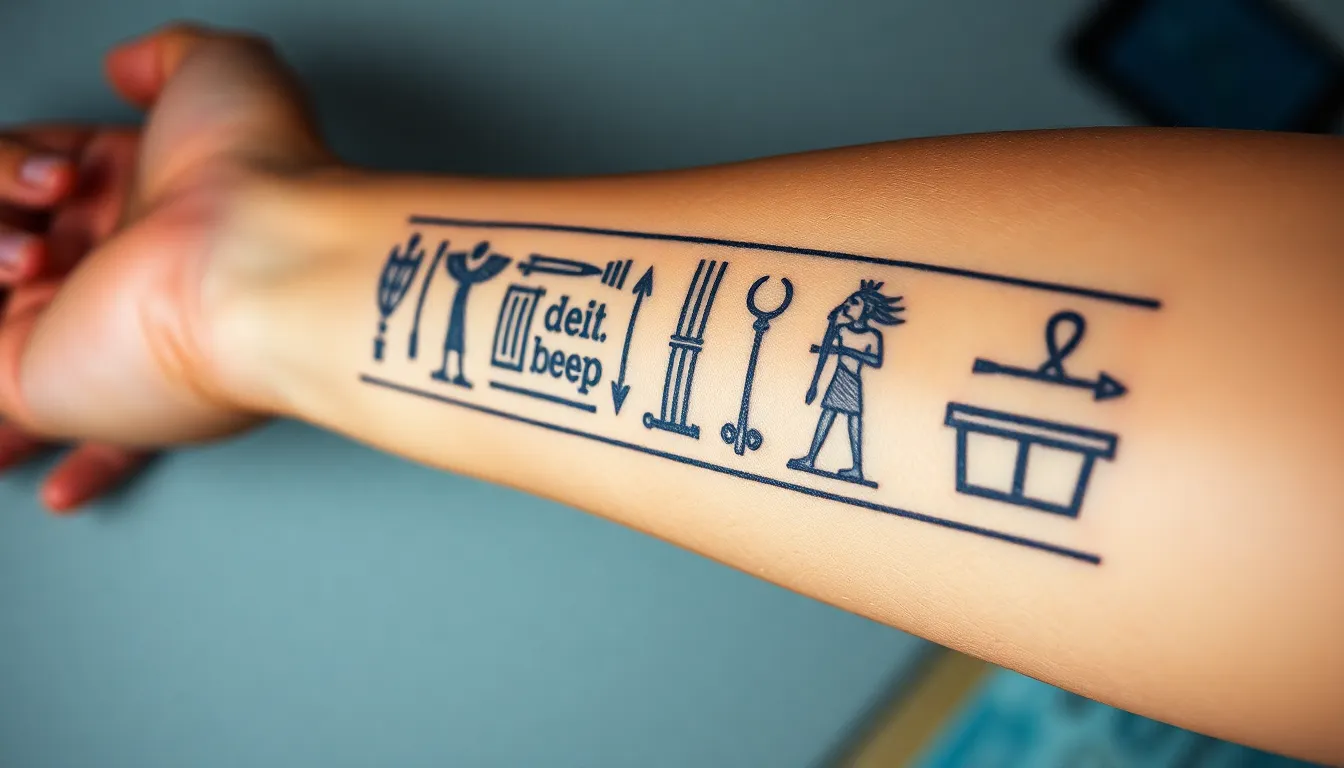
Ancient hieroglyphic scripts offer endless possibilities for creating deeply personal and meaningful tattoo designs that connect us to Egypt’s rich linguistic heritage.
Personal Name Translations in Hieroglyphs
Translating your name into hieroglyphics creates a unique tattoo that bridges modern identity with ancient symbolism. We can work with tattoo artists who specialize in Egyptian translations to ensure accurate representation of each letter or sound in your name. Individual hieroglyphs carry exact meanings beyond their phonetic value, such as symbols representing life, protection, or renewal, which adds layers of significance to personal name tattoos.
Consider incorporating your loved ones’ names alongside your own to create a family tribute in ancient script. These designs work exceptionally well as wrist bands, along the forearm, or down the spine where the vertical nature of hieroglyphic writing flows naturally with your body’s lines.
Meaningful Egyptian Phrases and Quotes
“Ma’at” stands as one of the most powerful Egyptian phrases for tattoos, symbolizing truth and balance in a single hieroglyphic expression. This concept represents the fundamental Egyptian belief in justice and harmony, making it perfect for those who value ethical living and moral strength.
“Ankh Ua Djet” combines the famous Ankh symbol with hieroglyphs meaning “Life Eternal,” creating a phrase that expresses your commitment to everlasting existence and spiritual continuity. We often see this phrase incorporated into larger Egyptian themed pieces or used as a standalone statement tattoo.
Phrase tattoos work beautifully when you combine multiple hieroglyphs to form complete sentences that express your personal beliefs or commemorate special life events. These designs can wrap around your arm, follow your collarbone, or create vertical statements along your ribs.
Cartouche Designs with Royal Symbolism
Cartouches bring the power of pharaonic tradition to modern tattoo art through their distinctive oval shape with a horizontal line at the bottom. Originally used to encircle pharaohs’ names, these royal symbols now frame personal names to represent individual power and lasting legacy.
We recommend incorporating additional hieroglyphs around your cartouche design to enhance its symbolic meaning, often representing concepts like journey, protection, or divine favor. These surrounding elements create a complete narrative that tells your personal story through ancient Egyptian imagery.
Pharaonic names within cartouches make striking tattoo centerpieces, especially when you choose rulers like Cleopatra, Tutankhamun, or Ramesses whose stories resonate with your personal values. The royal symbolism transforms your tattoo into a statement of strength and enduring influence that connects you to Egypt’s most powerful historical figures.
Iconic Egyptian Symbol Tattoos
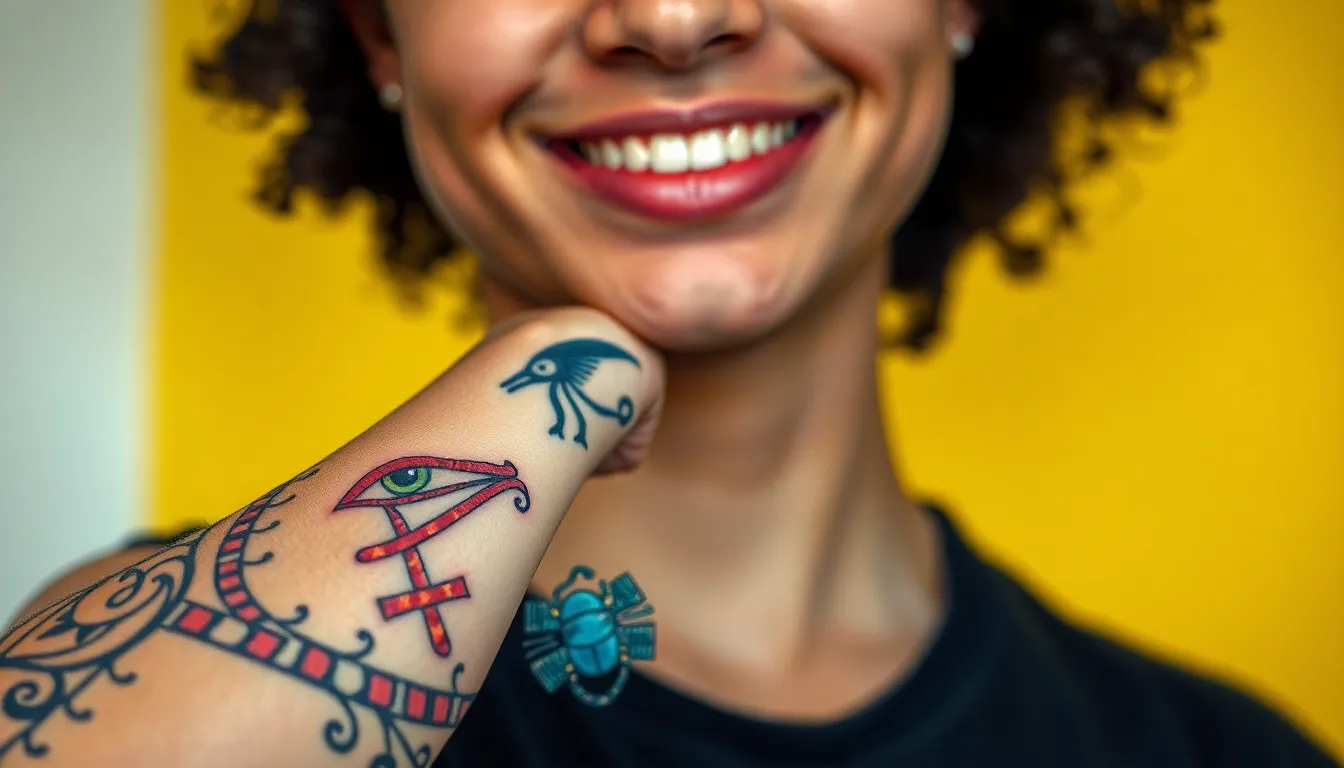
Egyptian symbols carry profound meanings that have resonated for thousands of years. These timeless designs offer tattoo enthusiasts powerful ways to connect with ancient wisdom and spiritual protection.
Eye of Horus for Protection and Good Health
Eye of Horus tattoos represent protection, healing, and divine power in Egyptian mythology. We see this symbol frequently chosen by people seeking spiritual safeguarding and enhanced intuition. Artists often incorporate the eye’s distinctive teardrop marking and falcon-inspired lines to create designs that emphasize clairvoyance and divine connection.
Placement options include the forearm, shoulder blade, or chest where the symbol’s protective energy can be prominently displayed. Many clients combine the Eye of Horus with pyramids, hieroglyphics, or geometric patterns to enhance its mystical appearance.
Ankh Symbol Representing Eternal Life
Ankh symbol tattoos embody eternal existence, life, and immortality through their distinctive cross-like shape topped with a loop. We recommend this “key of life” design for individuals who want to celebrate life’s eternal cycle and the union of opposites. The ankh’s simple yet powerful form makes it versatile for various tattoo styles and sizes.
Traditional black ink creates classic appeal, while colored versions using gold, blue, or red can incorporate authentic Egyptian palette choices. Popular placements include the wrist, behind the ear, or as part of larger Egyptian themed sleeves.
Scarab Beetle for Transformation and Rebirth
Scarab beetle tattoos symbolize transformation, rebirth, and life’s eternal cycle through their connection to the sun god Ra’s daily journey. We find these designs particularly meaningful for people experiencing major life changes or personal growth. Artists typically render scarabs with detailed wing patterns, hieroglyphic backgrounds, or solar disk imagery.
Color choices range from traditional black and gray to vibrant blues, greens, and golds that reflect the beetle’s iridescent natural appearance. Chest pieces, back tattoos, and upper arm placements provide adequate space for intricate scarab details and accompanying Egyptian elements.
Djed Pillar for Stability and Strength
Djed pillar tattoos represent stability, strength, and endurance through their association with the god Osiris and ancient Egyptian architecture. We see clients choosing this symbol when they want to emphasize personal resilience and unwavering foundations. The pillar’s vertical lines and distinctive top section create striking geometric compositions.
Artists often incorporate the djed pillar into larger Egyptian scenes featuring pyramids, temples, or other architectural elements. Spine placements naturally complement the pillar’s vertical orientation, while forearm and calf locations offer excellent visibility for this symbol of durability and spiritual backbone.
Pharaoh and Royal Egyptian Tattoo Concepts
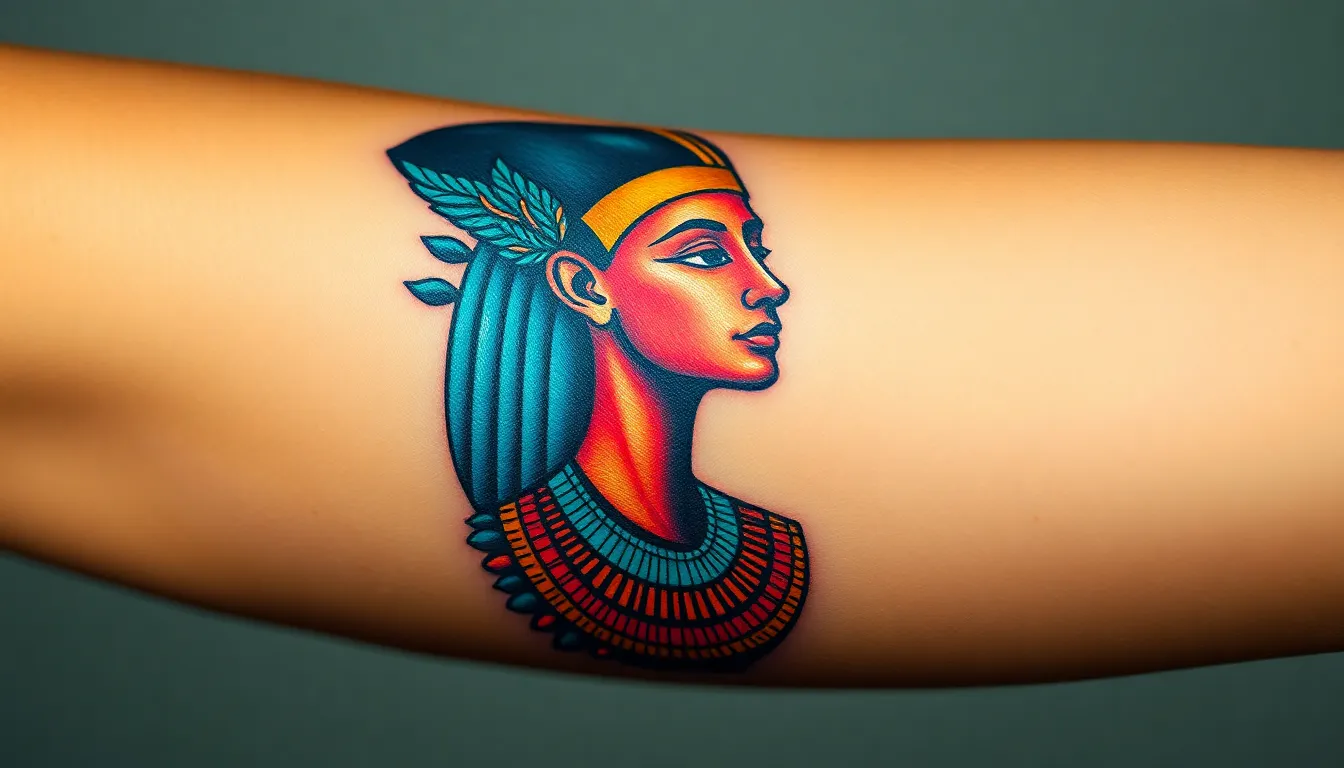
Royal Egyptian tattoo designs capture the majesty and divine authority of ancient pharaohs, offering powerful symbols of leadership and eternal legacy. These regal motifs transform your skin into a canvas celebrating Egypt’s most iconic rulers and their sacred regalia.
Nefertiti Portrait Designs
Nefertiti’s iconic profile creates one of the most recognizable Egyptian tattoos, embodying timeless beauty and queenly grace. Artists often emphasize her elongated neck and distinctive crown, using fine line work to capture the delicate features that made her legendary. Popular placements include the shoulder blade or forearm where the portrait’s vertical elegance shines. Color variations range from classic black and grey realism to vibrant jewel tones that highlight her royal headdress and jewelry. We recommend incorporating subtle hieroglyphic elements around the portrait to enhance the historical authenticity of your design.
King Tutankhamun Mask Illustrations
King Tut’s golden burial mask represents the pinnacle of pharaonic symbolism, making it a striking centerpiece for Egyptian themed tattoos. The intricate details of the mask offer artists opportunities to showcase metallic gold ink effects and precise geometric patterns. Traditional designs focus on the mask’s frontal view, emphasizing the cobra and vulture symbols that crown the young pharaoh’s head. Modern interpretations sometimes blend the mask with contemporary elements or incorporate it into larger Egyptian themed sleeves. Placement considerations include the chest for maximum visual impact or the upper arm where the mask’s rectangular proportions work naturally with muscle contours.
Cleopatra Inspired Feminine Designs
Cleopatra tattoos celebrate feminine power through Egypt’s most famous queen, combining beauty with political strength and intelligence. These designs often feature her distinctive eye makeup, elaborate headdresses, and serpentine symbols that reference her dramatic end. Artists frequently incorporate elements like lotus flowers, Egyptian jewelry patterns, or asp imagery to create uniquely feminine interpretations. Color palettes typically emphasize deep purples, gold accents, and emerald greens that reflect her legendary wealth and status. We suggest considering placement on areas that complement the design’s flowing elements, such as the ribcage or thigh.
Pharaoh Headdress and Crown Motifs
Pharaoh headdresses transform any tattoo into a symbol of divine authority and royal bloodline, representing the sacred connection between earthly rulers and Egyptian gods. The nemes headdress, striped in blue and gold, creates bold geometric patterns perfect for larger tattoo pieces. Crown designs can stand alone as powerful statement pieces or integrate seamlessly with other Egyptian elements like ankh symbols or hieroglyphic borders. These motifs work exceptionally well in full sleeve compositions where their regal presence anchors the entire design. Placement options include the upper arm, back, or chest where the crown’s proportions can achieve maximum dramatic effect.
Egyptian Architecture and Monument Tattoos
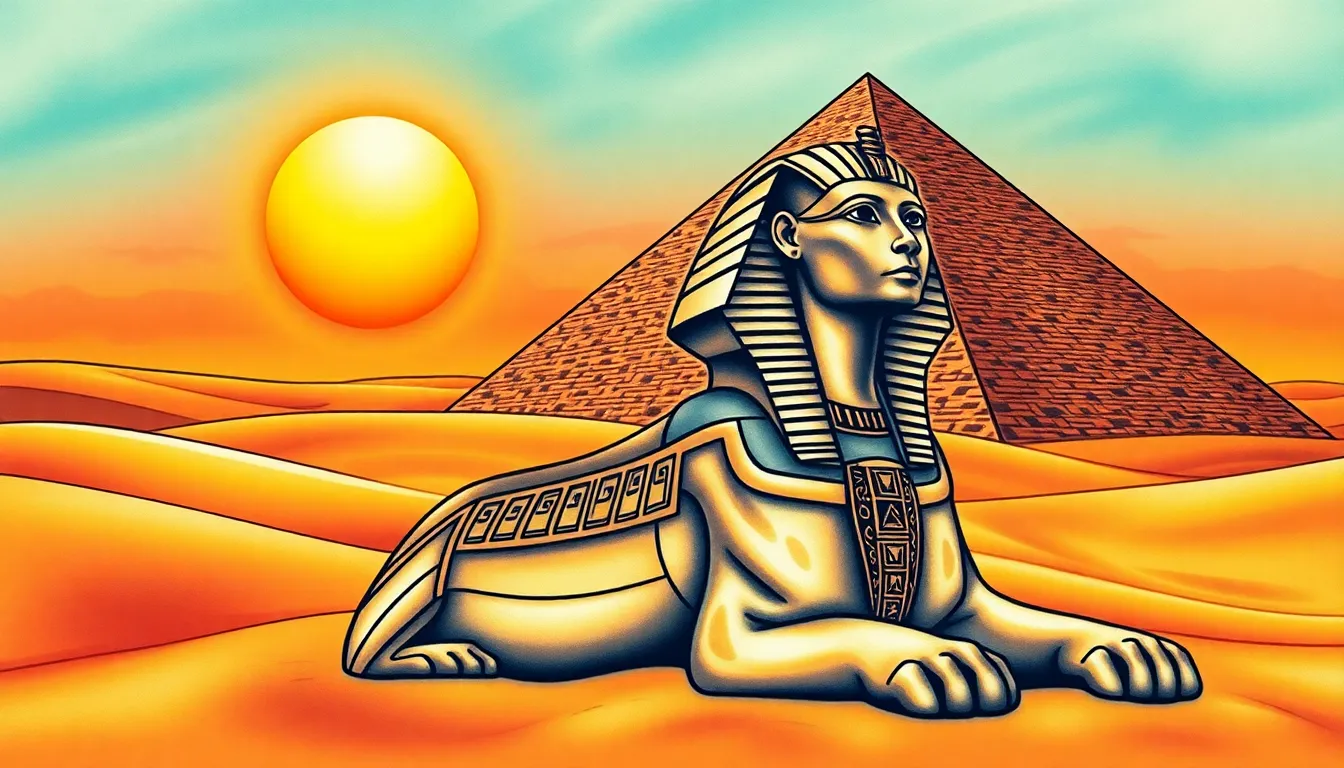
Architecture forms the backbone of Egypt’s most recognizable tattoo designs. These monumental structures offer endless creative possibilities for tattoo enthusiasts seeking to capture the grandeur of ancient civilization.
Pyramid Designs with Desert Landscapes
Pyramids dominate Egyptian tattoo art with their powerful symbolism and striking visual appeal. With over 180 pyramids scattered across Egypt, we have countless design variations to choose from, ranging from simple geometric outlines to elaborate desert scenes.
Desert backdrops create stunning contrast when paired with pyramid silhouettes. Artists often incorporate the blazing sun, crescent moon, or twinkling stars to emphasize the ancient significance of these monuments. Sweeping sand dunes and sparse vegetation add depth and atmosphere to these compositions.
Scale variations make pyramid tattoos incredibly versatile for different body placements. Minimalist designs work perfectly for wrists or ankles, while detailed landscapes suit larger areas like shoulders or back pieces. Shading techniques can transform simple triangular shapes into three dimensional masterpieces that capture the pyramid’s imposing presence.
Sphinx Tattoos with Mystical Elements
Sphinx tattoos combine human intelligence with feline power to create compelling symbolic artwork. The creature’s human head represents wisdom and consciousness, while its lion body embodies strength and courage.
Mystical elements elevate sphinx designs beyond simple animal portraits. The Eye of Providence often appears above or within the composition, adding spiritual protection to the tattoo’s meaning. Anubis frequently accompanies sphinx imagery, creating powerful underworld themes that speak to life’s mysteries.
Artistic styles range from photorealistic portraits to abstract interpretations that emphasize the sphinx’s enigmatic nature. Geometric patterns and mandala elements can frame the central figure, while hieroglyphic borders add authentic Egyptian context. Color palettes typically feature golden yellows and deep browns that reflect the creature’s desert origins.
Ancient Temple Column Details
Temple columns provide intricate design opportunities through their elaborate carvings and architectural elements. These structures showcase the sophisticated artistry of ancient Egyptian craftsmen through detailed hieroglyphic inscriptions and decorative motifs.
Carved reliefs tell stories of gods, pharaohs, and daily life in ancient Egypt. Lotus flower capitals crown many column designs, symbolizing rebirth and the sun’s daily journey across the sky. Papyrus bundle motifs represent the Nile Delta’s marshlands and their life giving properties.
Isolated column elements work beautifully as standalone tattoos or complementary pieces in larger Egyptian themed compositions. The vertical nature of columns makes them ideal for forearm, shin, or spine placements where their length can be fully appreciated. Fine line work captures the delicate details of carved hieroglyphs and decorative borders.
Obelisk Structures with Hieroglyphic Inscriptions
Obelisks stand as towering monuments to Egyptian engineering and spiritual beliefs. These four sided pillars traditionally honored sun gods and marked important locations throughout the ancient kingdom.
Hieroglyphic inscriptions transform obelisk tattoos into personalized storytelling devices. Ancient texts praising pharaohs or invoking divine protection can be adapted to carry modern meanings about strength, achievement, or spiritual guidance. The vertical format naturally accommodates lengthy inscriptions that flow from base to pinnacle.
Architectural details include the pyramid shaped capstone called a pyramidion, which often featured gold or electrum plating to catch the sun’s rays. Shadow work and gradient shading can replicate this gleaming effect in tattoo form. Base foundations and supporting platforms add stability to the overall composition while providing space for additional decorative elements.
Egyptian Mythology Scene Tattoos
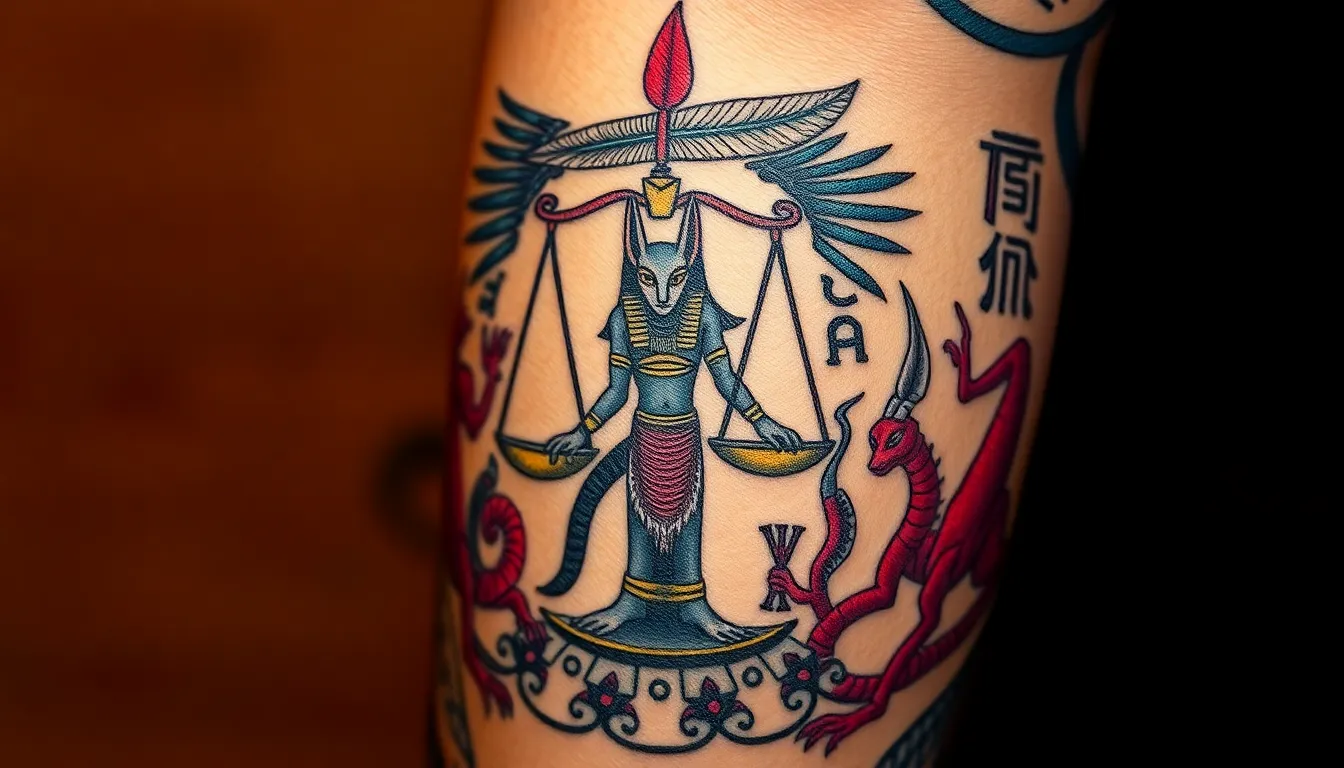
We’ll now explore complex narrative tattoo designs that tell complete stories from Ancient Egyptian mythology. Scene tattoos offer opportunities to create immersive artwork that captures epic tales of gods, death, and eternal life.
Journey Through the Underworld Depictions
Journey tattoos capture the soul’s passage through the Egyptian underworld known as Duat. Scenes from the Book of the Dead serve as artistic blueprints for these intricate designs, showing the deceased handling through twelve gates and various challenges. Anubis appears prominently in these tattoos as the guide who escorts souls through dangerous underworld passages filled with serpents and demons.
Complex underworld scenes often feature the solar barque of Ra traveling through nighttime realms. Tattoo artists frequently incorporate hieroglyphic text from actual Book of the Dead papyri to enhance authenticity. Popular placement areas include full back pieces and sleeve tattoos that allow space for detailed storytelling elements.
Weighing of the Heart Ceremony
Weighing ceremony tattoos depict the most crucial moment in Egyptian afterlife beliefs. Ma’at appears as the feathered goddess of truth and justice, watching over scales that determine eternal fate. Heart weighing scenes typically show Anubis operating the scales while Thoth records the judgment with his ibis head and scribal tools.
Ammit the Devourer waits nearby in these tattoo designs, ready to consume hearts heavier than Ma’at’s feather of truth. Detailed ceremony tattoos often include the Hall of Two Truths with its 42 judges observing the proceedings. Forearm and upper arm placements work well for these horizontal compositions that read like ancient Egyptian wall paintings.
Creation Myths and Cosmic Battles
Creation myth tattoos showcase primordial Egyptian stories of industry formation. Atum emerging from primordial waters appears in tattoos as a self created deity bringing forth the first land. Nut and Geb represent sky and earth in cosmic embrace scenes that span across larger tattoo canvases like chest pieces and back work.
Seth and Osiris battle scenes capture the eternal conflict between order and chaos in Egyptian mythology. Set appears with his distinctive curved snout and red coloring while dismembering his brother Osiris. Tattoo compositions often show Horus later avenging his father through aerial combat scenes filled with hieroglyphic magic spells.
Resurrection and Rebirth Stories
Resurrection tattoos focus on Osiris’s return from death through Isis’s magical intervention. Isis appears with outstretched wings protecting the mummified form of Osiris while performing resurrection spells. Scarab beetles frequently accompany these scenes as symbols of daily rebirth and eternal renewal cycles.
Osiris emerges in green skin tones representing vegetation and life force returning to the industry. Tattoo artists often incorporate lotus flowers blooming from mummy wrappings to symbolize life emerging from death. These powerful rebirth narratives work exceptionally well as full sleeve tattoos that can accommodate the complex resurrection process from death through mummification to divine rebirth.
Modern Egyptian Tattoo Style Variations
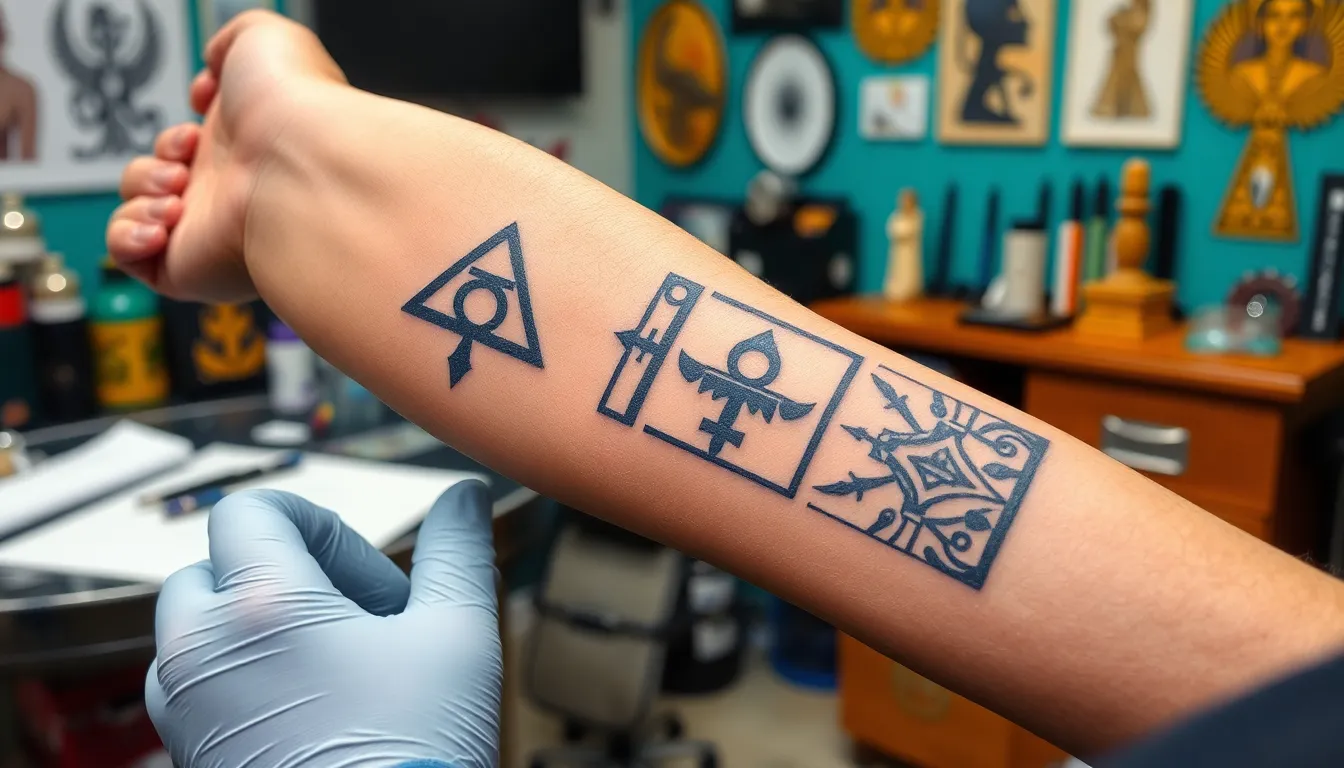
Contemporary tattoo artists have reimagined ancient Egyptian designs through innovative techniques and styling approaches. We’re seeing artists blend traditional symbolism with modern tattooing methods to create unique interpretations of this timeless art form.
Geometric Egyptian Patterns and Designs
Geometric patterns transform ancient hieroglyphs and temple motifs into stunning mathematical compositions. We see artists incorporating symmetrical designs that mirror the precision found in pyramid construction and pharaonic architecture. These patterns often feature interlocking triangles representing pyramid structures, circular motifs inspired by sun discs, and linear elements that echo temple column designs.
Artists frequently combine multiple geometric shapes to create complex mandalas incorporating Egyptian symbols like the ankh, djed pillar, and eye of Horus. Bold line work defines these designs, creating striking visual impact through repetitive patterns that celebrate ancient Egypt’s mathematical achievements. Placement options range from forearm sleeves to back pieces, allowing artists to showcase intricate detailing across larger canvas areas.
Watercolor Egyptian Tattoo Techniques
Watercolor techniques bring ethereal beauty to traditional Egyptian imagery through soft color bleeding and fluid transitions. We’re observing artists apply vibrant blues and golds behind scarab beetles, creating luminous backgrounds that enhance the mystical qualities of these sacred insects. Soft color washes work particularly well with falcon imagery, where artists blend oranges and purples to capture sunset desert atmospheres.
Artists often combine watercolor backgrounds with solid black line work for Egyptian portraits, creating striking contrasts between realistic details and abstract color elements. Lotus flowers benefit tremendously from watercolor techniques, as artists can capture the delicate petal gradations and natural color variations. These designs require skilled artists who understand both traditional Egyptian symbolism and contemporary watercolor application methods.
Minimalist Egyptian Symbol Approaches
Minimalist designs focus on essential symbolic elements using clean lines and simplified forms. We recommend single line ankh symbols for clients seeking subtle yet meaningful tattoos, as these designs maintain powerful symbolism while occupying minimal skin space. Small eye of Horus tattoos work exceptionally well behind ears or on wrists, providing discrete protection symbolism.
Fine line techniques allow artists to create delicate hieroglyphic sequences that read like personal mantras or meaningful phrases. These designs often feature single symbols like simplified scarab outlines, basic pyramid shapes, or streamlined falcon silhouettes. Artists emphasize negative space usage to create visual balance, ensuring each element maintains its symbolic integrity even though reduced complexity.
Realistic Black and Gray Egyptian Portraits
Realistic portraits in black and gray capture the intensity and grandeur of Egyptian deities and pharaohs through detailed shading techniques. We see artists creating lifelike depictions of Anubis with intricate fur texturing and piercing eyes that convey his role as guardian of the afterlife. Isis portraits showcase flowing headdresses and serene expressions that emphasize her nurturing divine qualities.
Artists use various gray tones to create depth and dimension in pharaoh mask representations, particularly when depicting King Tutankhamun’s burial mask with its distinctive striped headdress and cobra details. Cleopatra portraits benefit from careful attention to facial features and ornate jewelry details that reflect her legendary beauty and power. These designs require substantial time investment and skilled portraiture techniques to achieve museum quality results that honor these historical figures appropriately.
Placement Ideas for Egyptian Tattoos
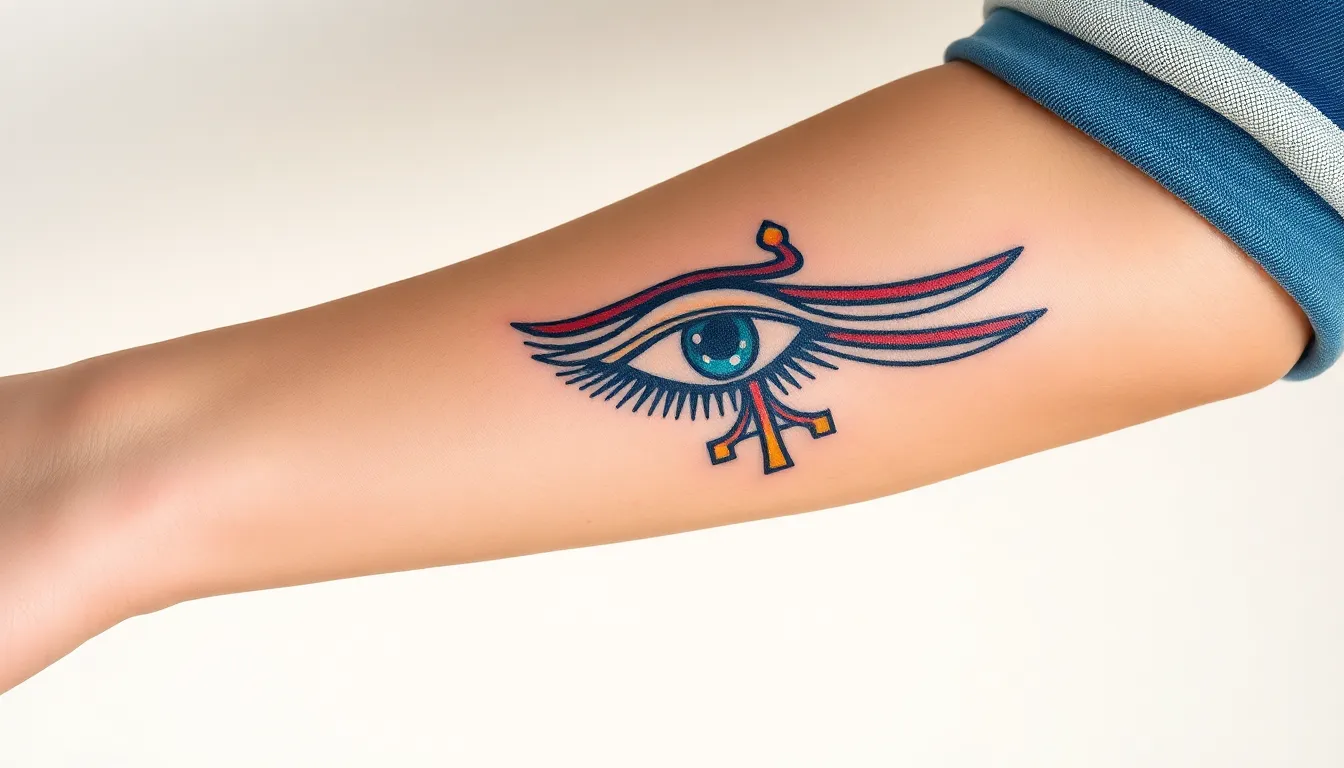
Choosing the right placement for your Egyptian tattoo enhances both its visual impact and personal significance. We’ll explore strategic locations that complement different design sizes and showcase your connection to ancient Egyptian culture.
Large Back Pieces for Detailed Scenes
Expansive back canvases accommodate intricate Egyptian narratives like the journey through the underworld or elaborate pyramid complexes. We recommend this placement for detailed depictions of the Pyramids of Giza combined with sphinx guardians and hieroglyphic borders.
Full back designs excel at storytelling through connected scenes featuring multiple deities such as Anubis, Isis, and Horus arranged in chronological sequences. Artists can incorporate architectural elements like temple columns and obelisks alongside mythological characters to create comprehensive Egyptian landscapes.
Vertical compositions work particularly well for depicting the soul’s journey from earthly life to the afterlife, with Anubis guiding the deceased through various underworld realms. These designs often include the weighing of the heart ceremony with Ma’at’s feather as the central focal point.
Forearm Designs for Visible Symbolism
Forearm placements showcase meaningful Egyptian symbols like the Eye of Horus or ankh crosses where they’re easily visible and personally accessible. We find this location perfect for medium sized designs that incorporate hieroglyphic text alongside iconic imagery.
Wraparound forearm tattoos create ever-changing storytelling opportunities featuring scarab beetles emerging from lotus flowers or serpentine designs that spiral around the arm. These designs often incorporate cartouche elements containing personal names translated into hieroglyphics.
Linear hieroglyphic phrases translate beautifully along the forearm’s natural length, allowing for meaningful quotes like “Ma’at” or “Ankh Ua Djet” to flow with the arm’s contours. Artists frequently enhance these text based designs with small symbolic accents like djed pillars or was scepters.
Chest and Shoulder Egyptian Motifs
Chest placements emphasize the spiritual significance of Egyptian symbols like the ankh positioned over the heart or protective Eye of Horus designs that guard the wearer. We observe that geometric patterns inspired by ancient Egyptian art translate exceptionally well across the chest’s broad surface.
Shoulder blade locations accommodate detailed deity portraits such as Nefertiti’s profile or Bastet’s feline features, often enhanced with traditional Egyptian color palettes and fine line work. These placements allow for impressive detail in facial features and ceremonial headdresses.
Combined chest and shoulder designs create flowing compositions that can incorporate pharaoh crowns extending from shoulder to chest, or wing motifs inspired by Isis spreading protectively across the upper torso. Artists often use these larger canvases for watercolor techniques that bring ancient symbols to life with vibrant blues and golds.
Small Wrist and Ankle Egyptian Symbols
Delicate wrist tattoos feature minimalist Egyptian elements like simplified ankh symbols, small scarab beetles, or single hieroglyphic characters that maintain their symbolic power in compact designs. We recommend these placements for individuals preferring subtle yet meaningful Egyptian connections.
Ankle locations work beautifully for small pyramid outlines or geometric patterns inspired by ancient Egyptian jewelry and amulets. These discreet placements often incorporate single deity symbols like Bastet’s cat silhouette or Horus’s falcon eye rendered in clean, simple lines.
Matching wrist and ankle sets create symbolic connections between protective symbols, with the Eye of Horus on one wrist balanced by an ankh on the opposite ankle. Artists frequently use fine line techniques for these smaller pieces, ensuring crisp detail even though the limited space available.
Conclusion
Egyptian tattoo art offers us an incredible journey into one of history’s most fascinating civilizations. We’ve explored how these timeless symbols can create deeply personal connections to ancient wisdom while expressing our individual stories through ink.
From simple ankh designs to elaborate mythological narratives these tattoos provide endless possibilities for meaningful body art. Whether we choose protective symbols like the Eye of Horus or complex scenes depicting the afterlife journey each design carries profound spiritual significance.
The beauty of Egyptian tattoos lies in their versatility. We can embrace minimalist geometric patterns or opt for detailed realistic portraits of pharaohs and deities. Modern techniques like watercolor effects breathe fresh life into ancient symbolism while honoring traditional meanings.
Remember that placement matters just as much as design choice. Strategic positioning enhances both visual impact and personal significance making our Egyptian tattoos truly groundbreaking pieces of art that celebrate this remarkable ancient heritage.
Frequently Asked Questions
What makes Egyptian tattoos so popular among tattoo enthusiasts?
Egyptian tattoos are popular because they combine stunning visual elements with deep spiritual meaning. Ancient Egyptian symbols like the Eye of Horus, ankh, and hieroglyphics represent powerful concepts such as protection, eternal life, and wisdom. These designs offer both aesthetic appeal and personal significance, making them meaningful choices for people seeking tattoos that connect them to one of history’s most fascinating civilizations.
Which Egyptian gods and goddesses are most commonly featured in tattoo designs?
The most popular Egyptian deities for tattoos include Anubis (jackal-headed god of the afterlife), Bastet (cat goddess of protection), Horus (falcon god of sky and kingship), and Isis (goddess of magic and motherhood). Each deity carries specific symbolic meanings – Anubis represents guidance through transitions, Bastet symbolizes protection and joy, Horus embodies royal power, and Isis represents nurturing and magical abilities.
Can I incorporate my name into an Egyptian-style tattoo?
Yes, you can translate your name into hieroglyphics for a personalized Egyptian tattoo. Cartouche designs are particularly popular – these oval frames containing hieroglyphic names were traditionally used for royal names in ancient Egypt. This creates a unique tattoo that blends your modern identity with ancient symbolism, making it both personal and historically connected.
What do common Egyptian symbols like the ankh and Eye of Horus represent?
The ankh symbolizes eternal life and is often chosen by those celebrating life’s cycles. The Eye of Horus represents protection, healing, and spiritual safeguarding. Other popular symbols include the scarab beetle (transformation and rebirth) and the djed pillar (stability and strength). Each symbol carries profound spiritual meaning rooted in ancient Egyptian beliefs about life, death, and divine protection.
Where should I place my Egyptian tattoo for maximum impact?
Placement depends on your design’s size and personal preference. Large narrative scenes work best on the back or chest, allowing space for detailed storytelling. Forearms are ideal for visible symbols like the Eye of Horus or hieroglyphics. Chest and shoulder placements suit spiritual motifs, while small wrist or ankle tattoos offer subtle connections to Egyptian symbolism.
What modern tattoo styles work well with Egyptian themes?
Contemporary Egyptian tattoos can incorporate geometric patterns, watercolor techniques, minimalist designs, or realistic black and gray portraits. Geometric styles transform ancient motifs into symmetrical patterns, while watercolor adds vibrant colors to traditional imagery. Minimalist approaches focus on essential symbolic elements with clean lines, and realistic portraits capture the grandeur of pharaohs and deities.
Are Egyptian tattoos suitable for both large and small designs?
Absolutely. Egyptian tattoos are highly versatile – you can choose from small, simple symbols like an ankh or Eye of Horus for subtle placement, or opt for elaborate full-back pieces depicting complex mythological scenes. Medium-sized designs work well for forearms or shoulders, featuring individual deities or hieroglyphic phrases that maintain detail while remaining manageable in size.
